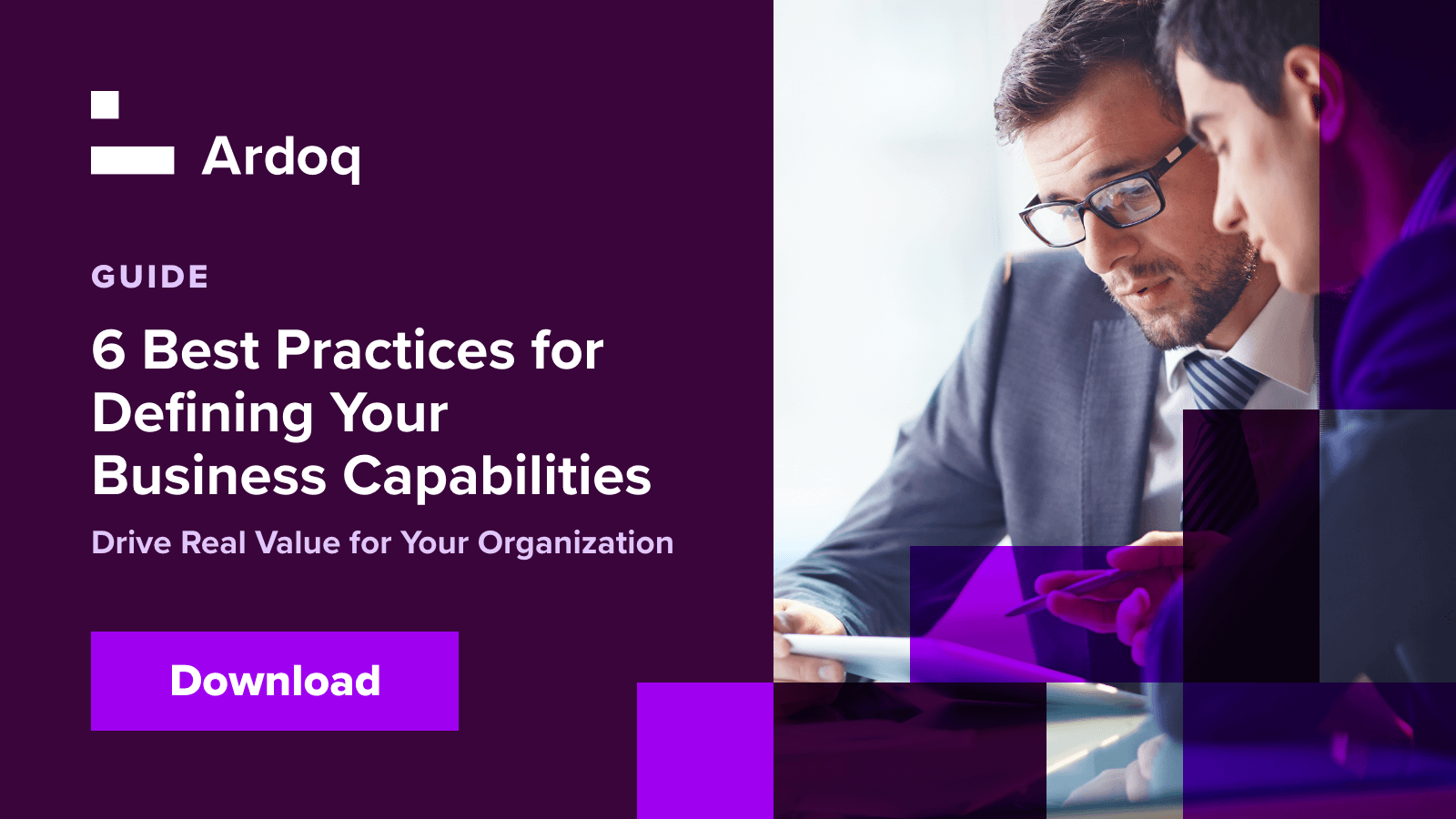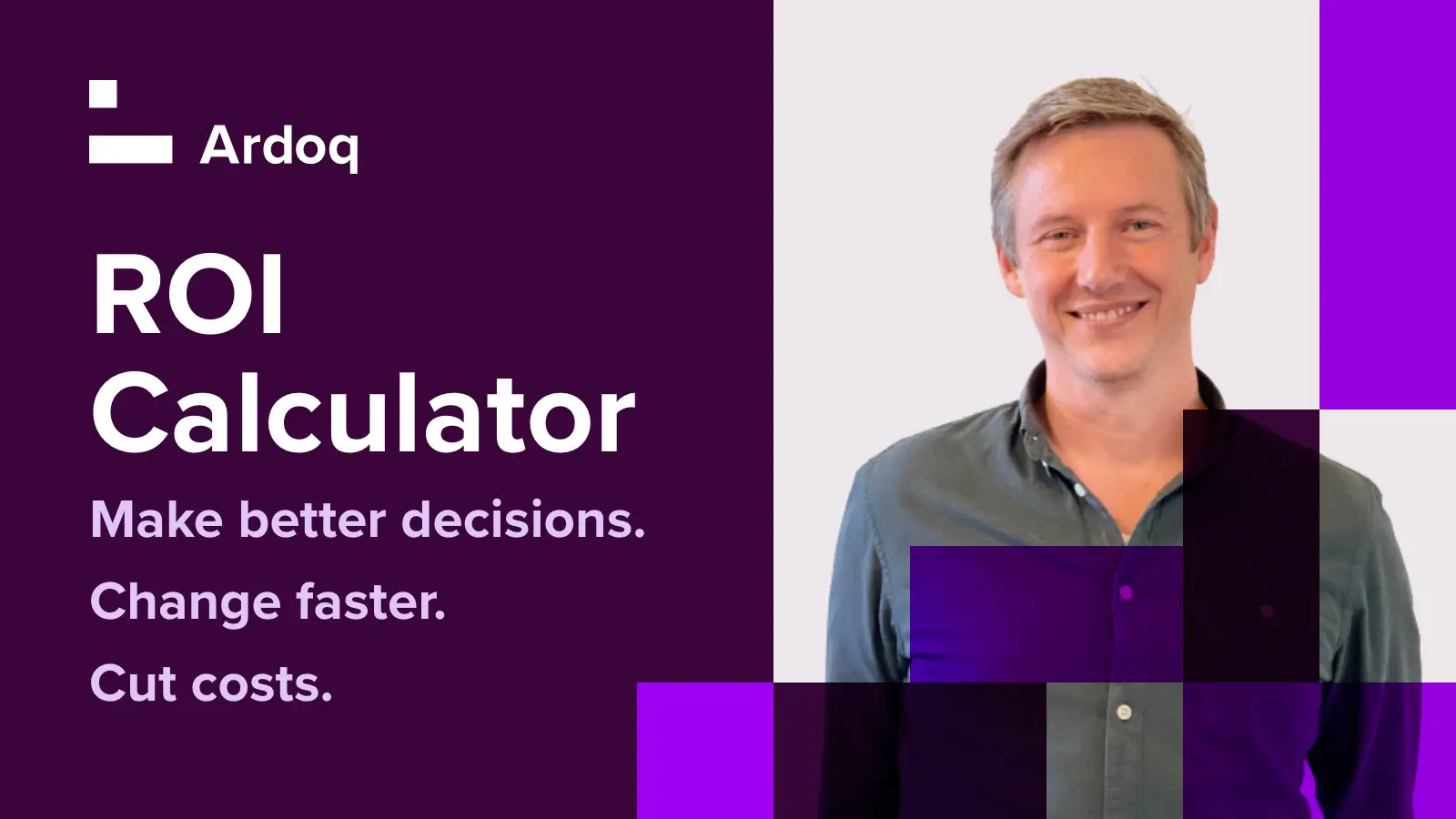What high-level business problems does Ardoq solve? What business outcomes can Enterprise Architects achieve using this data platform? In this article, we list the top seven outcomes you can expect and how Ardoq’s ready-to-use solutions enable you to achieve them quickly.
For the past ten years, industry experts have been advising Enterprise Architects to become “outcome-driven”. Gartner1, for example, says:
“We have seen an evolution in EA from a traditional technology and compliance focus to a business-outcome-driven approach, which begins with the business, and now as internal management consulting.”
Yet despite so much focus on outcomes, it’s difficult to describe those outcomes and the best practices for reaching them. How do Enterprise Architects articulate their goals in real life and measure the results?
These are the challenging questions we’ve been dedicated to exploring and answering at Ardoq since the company was founded ten years ago. Ardoq consultants have discussed “business outcomes” at hundreds of meetings with CIOs, Enterprise Architects, and Business Architects in large enterprises across almost every industry.
The findings are clear: every person uses different terms to describe what they want to achieve, and everyone takes different paths. There isn’t one set of universal “outcomes” because no two architecture teams are in the exact same situation. Each team has specific objectives, operates in a unique business environment with a multitude of factors to consider, and interacts with numerous stakeholders with substantially different expectations.
Despite these differences, we found some common themes. We grouped these themes into seven overarching outcomes every business can achieve with EA, and we identified the most common steps architects take to achieve them.
Seven Core Outcomes for Every Business
- Ensure Business/IT Transparency and Collaboration
- Improve IT Governance, Risk, and Control
- Improve Data Governance, Risk, and Control
- Reduce IT Complexity and Spend
- Improve Impact Analysis
- Drive Business Transformation and Innovation
- Improve Strategic (Re)prioritization and Planning
These outcomes are simplifications of EA in practice - there are many paths and factors that lead to EA excellence. Some outcomes may overlap, while others may not be relevant in your current situation. In any case, this list makes it easier for you to plan and communicate Enterprise Architecture initiatives in a way that everyone - from the boardroom to the back office - can understand.
A High-Level Approach to Using These Outcomes
The fundamental recipe for driving successful outcome-focused EA in your organization can be distilled into five broad steps.
- Ask key stakeholders what they need and decide which outcomes you realistically can achieve in the next 6-12 months
- Prioritize the outcomes and agree on key performance metrics with relevant stakeholders (both those who are interested in the initiative and those who may be affected by it)
- Gather data and answer key questions related to each outcome (includes modeling at the appropriate level of abstraction )
- Share the findings with stakeholders
- Regularly evaluate and communicate the progress on prioritized outcomes
For each outcome detailed below, we highlight key terms or phrases that will help you pinpoint the ones most relevant to your organization, some key questions to use when engaging stakeholders, and the relevant Ardoq solutions that will accelerate your execution for each outcome.
Outcome 1: Ensure Business/IT Transparency and Collaboration
This outcome covers two related concerns:
- The need to understand how business and IT fit together to achieve business goals
- The need for people to engage with this information, stay informed, and up to date
This outcome may be achieved by having appropriate governance over IT and data (i.e. Outcomes 2 and 3 below), but because it is so important in many organizations yet so challenging, we have put it in its own category.
Common terms used to describe this outcome:
- Drive engagement across the wider organization
- Transparency
- Understanding how business and IT fit together
- Understand how business and IT work together
- How do capabilities and processes get implemented
- How does IT support business processes or value streams
- Align business and IT
- As-is, current-state, single source of truth
- Common foundation of IT information
Key questions connected with the outcome:
- How are my business and technical capabilities implemented?
- How well does IT support the business?
- Which parts of the business are using IT?
- Do we have control of operating costs?
- How are IT costs assigned to business capabilities and departments?
- How do we get people outside of the EA team engaged to both utilize and update EA deliverables?
Relevant out-of-the-box Ardoq solutions for this outcome:
- Application Lifecycle Management
- Business Capability Modelling
- Technology Capability Modelling
- IT Cost Management
Outcome 2: Improve IT Governance, Risk, and Control
This outcome focuses on maintaining full information about the IT landscape and ensuring it meets policies for compliance, risk, and control. It also involves executing the processes (reviews, approvals, exception handling) needed to maintain information about the respective technology portfolios.
This is about understanding the current state of processes, not planning forward-looking enterprise transformation.
Common phrases used to describe this outcome:
- Ownership of IT
- Maintain relevant information for governance and compliance
- GDPR requirements or other industry-specific compliance (e.g., healthcare and financial services)
- IT risk management
- IT incident management
- IT problem management
- Application ownership
- Getting control of shadow IT
- Roles and responsibilities in managing IT
- Manage technical debt
- IT standards and guardrails
- Control IT cost
Key questions connected with the outcome:
- Which applications do we have, who is responsible for them, and what stage are they at in their lifecycle?
- Which infrastructure components do we have, who is responsible for them and what stage are they at in their lifecycle?
- How do my applications integrate, and what is the data that passes between the systems?
- What infrastructure supports my application portfolio?
- Do we govern our portfolio with an acceptable level of risk?
Relevant out-of-the-box Ardoq solutions for this outcome:
- Application Lifecycle Management
- Application Hosting
- Application Integration Management
- IT Lifecycle Management
- Technology Capability Realization
Outcome 3: Improve Data Governance, Risk, and Control
This outcome is about improving the way an organization manages and controls information and data. Information is a major asset for a company, and it needs its own governance, risk, and control, just like the IT portfolio does.
Common phrases used to describe this outcome:
- Increase usage of data and improvement of data quality
- Data lineage
- Control of PII, sensitive, or restricted information
- Information management, architecture, and security
- Understand which data sources feed analytics processes
- Data and information ownership
- Methods to detect, correct, and prevent errors in data and information
- Training programs relating to Information Security and Data Governance
- Data stewardship, lifecycle, resilience, and consistency
Key questions connected with the outcome:
- Do we have control of our data and its risk implications?
- Do we have control of where data is geographically located?
- How does data flow through the business and IT?
Relevant out-of-the-box Ardoq solutions for this outcome:
- Application Lifecycle Management
- Data Lineage

Outcome 4: Reduce IT Complexity and Spend
This outcome is all about improving IT and the efficiency or effectiveness of IT processes. It is driven primarily by IT objectives, such as lower IT costs and improved IT services - as opposed to wider business objectives.
This outcome may include digitizing basic processes, but not necessarily a large-scale digital transformation that changes how the business operates.
Common phrases used to describe this outcome:
- Reduce business and IT complexity
- Improve IT services efficiency
- Reduce technical debt
- Map current and future state architectures
- Reduce legacy technology
- IT modernization
- Post-merger IT integration
Key questions connected with the outcome:
- How do we modernize IT and exploit new technologies?
- How do we plan and execute IT strategy?
- How do we reduce IT complexity?
- Which application can be removed from my organization with minimal impact?
- What are the potential savings in our technology portfolio?
Relevant out-of-the-box Ardoq solutions for this outcome:
Outcome 5: Improve Impact Analysis (for changes or incidents)
This outcome is about identifying the impact of proposed changes to business and IT, such as migrating applications to the cloud or launching a new platform. Whenever a change is planned, the effect needs to be analyzed, understood, and managed. Several people, or even hundreds of people, will need to be involved and informed.
Common terms used to describe this outcome:
- Team, process, integration, impact analysis
- Shorten analysis time
- Improved pre-project speed
- Dependency analysis
- Root cause analysis
- Problem management
Key questions connected with the outcome:
- How will change impact the business architecture and the IT architecture?
- What are the ripple effects of making the change on the IT portfolio and ongoing initiatives?
- What factors should the project take into account?
- Who needs to be involved in making the change?
Relevant out-of-the-box Ardoq solutions for this outcome:
- Application Hosting
- Application Integration Management
- Business Capability Realization
- Business Process Management
Outcome 6: Drive Business Transformation and Innovation
This outcome is about identifying and putting broader business transformation goals and strategies in place and driving innovation. It is focused on improvement driven by business rather than purely IT improvement.
Common terms used to describe this outcome:
- Business transformation
- Digital transformation
- Business improvement
- Mergers & Acquisitions, post-merger integration, divestiture
- Target Operating Model (TOM)
- Business optimization
- Innovation and disruption
- Enterprise design
- Business target and transition architecture
Key questions connected with the outcome:
- How do we plan and execute business strategies that will impact IT?
- How do we execute strategic portfolio management?
- How do we track the execution of business change and react quickly when unexpected issues pop up?
- What is the cost of change in the organization?
Relevant out-of-the-box Ardoq solutions for this outcome:
- Strategy to Execution
- Cloud Migration
Outcome 7: Improve Strategic (Re)prioritization and Planning
This outcome is about the process of identifying, prioritizing, and executing initiatives to deliver on strategy and objectives. It also covers re-prioritizing items when the need arises.
Common phrases used to describe this outcome include:
- Strategy to execution
- Traceability from objectives to initiatives
- Progress on strategy implementation
- Project / Program Portfolio Management (PPM)
- Tracking IT projects
- Improved IT investment
- Maintaining business purpose for IT change
- Business roadmaps
- Technology strategy implementation
- Strategic Portfolio Management (SPM)
- To-Be architecture
- Options analysis
Key questions connected with the outcome:
- What are the projects we should prioritize and why?
- How do we evaluate the effort, cost, and time needed to execute initiatives?
- Who needs to be involved?
- What is the benefit of change for the company?
- How do we quickly re-prioritize when things change? (e.g., budget cuts)
- What is the acceptable level of projects we can execute?
- How do we identify which projects to stop?
Relevant out-of-the-box Ardoq solutions for this outcome:
- Strategy to Execution
Build Your EA Journey on Outcomes
Many Enterprise Architects have already implemented Ardoq’s scalable, out-of-the-box solutions to answer these vital business questions and become trusted enablers to CIOs and senior management. From Business Process Management to managing Technical Debt or rationalizing the Application Portfolio, these solutions are distilled from years of industry and EA expertise.
However, building or rebuilding an EA practice is a journey, and when you first start off, it may seem a bit overwhelming. You may have practical questions like: How do I get the data that is required? How do I best do an impact analysis and present the results? How do I get people, like application owners, to help me in the process?
We know it’s tricky, but our dedicated team of senior Enterprise Architects and solution specialists are here to help.
Get in touch with your questions or read some of our Customer Stories to hear firsthand about how they are moving their organizations ahead with the help of Ardoq.
1 Brand, S. (n.d.). 5 Steps to Professionalize the Delivery of Enterprise Architecture as an Internal Management Consultancy. Retrieved May 10, 2023, from https://www.gartner.com/en/documents/4342899 15%-25%
- Features Ardoq Discover | Enable Impactful Decisions in Your Organization How to Unlock the Full Value of EA | Thank You
- On-Demand Webinars Building a Global Map of a Business in Change The Business of Architecture: Achieving Business and IT Alignment
- Blog Posts What Is Ardoq and How Does It Work? Enterprise Architecture Tools: A Full Guide to Choosing Software
 Cynthia Kristensen
Cynthia is Senior Strategic Marketing Manager at Ardoq and has over 20 years experience in senior marketing roles and management teams at B2B tech companies.
Cynthia Kristensen
Cynthia is Senior Strategic Marketing Manager at Ardoq and has over 20 years experience in senior marketing roles and management teams at B2B tech companies.









